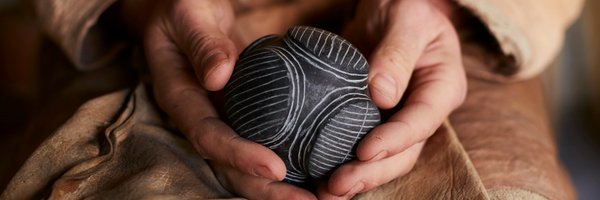
Dr. James Dilley
@ancientcraftUK
Followers
13,502
Following
950
Media
2,640
Statuses
23,300
Experimental Archaeologist @sotonarch ; Media consultant; Specialist in Flintknapping & Bronze casting: see my work displayed at @britishmuseum & @EH_Stonehenge
University of Southampton
Joined February 2012
Don't wanna be here?
Send us removal request.
Explore trending content on Musk Viewer
Liz Cheney
• 1233005 Tweets
Diddy
• 423219 Tweets
ORM HEARTBEAT UNSTOPPABLE
• 144289 Tweets
#Orm1stFMNanning
• 136272 Tweets
Cardi B
• 96577 Tweets
गोवर्धन पूजा
• 53310 Tweets
Ron Paul
• 34921 Tweets
三連休初日
• 34062 Tweets
HAPPY A'TIN ANNIVER5ARY
• 33484 Tweets
FB X CERAVE WINTER FTV
• 31380 Tweets
山陽新幹線
• 23209 Tweets
#YINWAR1STFANMEETING
• 22453 Tweets
michel
• 19472 Tweets
運転見合わせ
• 19417 Tweets
雨天中止
• 16855 Tweets
大雨警報
• 16291 Tweets
Fábio
• 14828 Tweets
土砂降り
• 14353 Tweets
運転再開
• 14319 Tweets
大雨の影響
• 14250 Tweets
GALA X CABARET
• 12916 Tweets
Renato
• 11839 Tweets
東海道新幹線
• 11644 Tweets
ピクミン
• 11236 Tweets
Gobert
• 10888 Tweets
Cold As You
• 10449 Tweets
#GovardhanPuja
• 10157 Tweets
Last Seen Profiles
Pinned Tweet
While filming for this BBC doc, I was for a moment, looking across into the Palaeolithic. A normally damp, isolated cave was alive with voices, fire light & the distant roar of red deer.
It was a moment that made me feel so fortunate to do what I do professionally!
#flintfriday
43
296
2K
Throw back to the creation of a “Levallois core”, a method of stone tool production favoured by Neanderthals. A stone is reduced down to a prepared core from which one or several preferred flakes are struck off. The other flakes were also used for simple flake tools
#flintfriday
16
190
834
One replica Neolithic axe head made of Langdale Tuff for
@gmacg_1
of
@Northlighter
, just needs a handle now. The speckling is iron pyrite within the layers of volcanic tuff. Axes of this rock have been found all over the UK, but the rock occurs only in a localised area
37
132
733
One of the highlights in the
@britishmuseum
's exhibition: The World of Stonehenge is Mesolithic a burial from Bad Dürrenberg, normally housed in
@MuseumHalle
. This special burial may be one of Europe's most convincing examples of a Shaman.
Heres why 👇👇👇
📸
@emmalouwynjones
14
192
691
Neolithic carved stone balls or "petrospheres" always draw questions at events & remain an enigma in prehistoric archaeology. Several hundred have been found, but never in groups or show evidence of impact or binding. Their purpose remains a mystery....
📸
@emmalouwynjones
71
138
674
Making a Neolithic flint axe at
@EH_Stonehenge
as part of the
#Ingenious
project by
@EnglishHeritage
17
204
601
After yesterday’s
#KnapTime
, I was shocked, proud and delighted at the interest (over 10K viewers!) and kind words. Today is back to some normality completing orders including these Neolithic arrowheads
12
42
596
It’s
#KnapTime
Wednesday! Today at 3pm I’ll show you how make a Neolithic axe head on live feed. I’ll tell you a bit about the archaeology and how I’ve used replicas experimental projects. Please share far and wide!
#museums
#prehistory
15
155
504
There has been news in the archaeology feeds about a major BBC documentary called "Attenborough and the Mammoth Graveyard" to be broadcast in late December featuring Sir David,
@Ben_garrod
,
@TheDigVenturers
and us! An amazing project to be part of & we hope to reveal more soon!
11
74
549
Laminar blade production is an effective way of maximising the available raw material with a high ratio of straight, sharp edges per kg of flint. Its a technique that appears around the start of the Upper Palaeolithic in Europe & continues into the early Neolithic
#flintfriday
13
109
510
Happy Winter Solstice!
As promised, here it is....our replica of the famous Nebra Sky Disc.
Normally in
@MuseumHalle
, the disc will be part of the World of
@EH_Stonehenge
exhibition in the
@britishmuseum
next year, which we are delighted to be playing a small part of!
9
76
440
It’s been a flinty week, what with
#KnapTime
and all the orders I’ve been working on. I had some joy this morning with this fairly grey Norfolk flint making long blades. I used an antler punch to indirectly flake them, hard work on such resistant material!
15
49
377
From all corners, Neolithic axes truly hold their own stories in stone across hundreds of miles & thousands of hours flaking then grinding against sandstone. These tools, and the quarrying to make them had one of the first major impacts on the landscape.
📸
@emmalouwynjones
8
62
382
One of the many stunning objects in
@Northlincmuseum
is this flint sickle found at Dragonby. It is believed to date to the early Bronze Age, and must have been made by an incredibly skilled knapper. Curved blades are very liable to snapping while flaking.
14
49
360
Alright, so
@CreswellCrags
have called in for some reinforcements for their
#CURATORBATTLE
. I’ve sent them some glass lithics recently, this is fresh off the...er...press?...hammers? 🤷♂️ Very hard to photograph so thought a video would show it off better! (Yes it’s pink glass)
19
57
347
A polished Neolithic axe (replica) on its way to a customer this week. This one is made of microdiorite (group VII) from North Wales near
@Museum_Pen
. Its had a really high polish so you can see the white and green crystals. Very proud of this one!
21
27
317
What are you doing at 21:00 GMT tomorrow??
Watching BBC 2 "Stonehenge: The Lost Circle Revealed" with
@theAliceRoberts
and Prof Mike Parker Pearson?
Luke Winter, the
@ATCranborne
team & myself take on a pretty rocky challenge using only Neolithic tools!
18
48
303
The appearance of the needle over 50,000 years ago may have provided the solution to allow Neanderthals to making clothing good enough to operate in harsher, cold environments. We still rely on this stitching device today that has saved far more than nine! 📸
@emmalouwynjones
5
68
307
A replica Neolithic flint-bladed sickle. The handle is partly based on an existing example from Central Europe. Sickle blades are particularly painful to make as they often snap during the last few flakes
#flintfriday
#archaeology31
9
53
276
I’ve made a few of these early Neolithic kite-shaped leaf arrowheads. Though this original one on display in
@BuxtonMuseum
is rather special. They are often very finely flaked anyway, but look how thin it is!!!
5
43
253
Testing a Must Farm style bronze axe!
The iconic two-part hafted axe found at
@MustFarm
has often raised questions over its effectiveness against a single part (one branch) hafted axe. But I can fully vouch for its ability to knock over trees!
📸
@emmalouwynjones
8
41
287
How to attached a Neolithic axe head to a handle, it’s surprisingly simple and doesn’t require glue, binding or anything other than a well made haft/handle. A bit of tool maintenance for your new replica
@gmacg_1
@Northlighter
9
51
248
Neolithic to early Bronze Age arrowheads in a timeline:
- Leaf arrowhead (Early Neolithic ~4000-3400 BC)
- Oblique arrowhead (Late Neolithic ~2600-2200 BC)
- Barbed & Tanged arrowhead (Late Neolithic - early Bronze Age ~2450-1600 BC)
📸
@emmalouwynjones
3
51
265
How I imagine a Stone Age hunting station: A well-used vantage point with natural shelter that played host to hunters making fresh stone tools from cores. A fire is created for light, warmth and to melt glue to fasten sharp tips onto spear shafts.
🎥
@emmalouwynjones
3
47
244
Made in their hundreds to fell thousands...
A tool that changed the British landscape above and below ground was the Neolithic axe. From around 6000 years ago they were produced in huge to fell the Mesolithic forest.
📸:
@emmalouwynjones
3
39
258
After yesterdays offering for the stunning axe head gallery, here is another from the
@Nationalmuseet
These Scandinavian style axes do appear in the UK (typically in eastern river basins) suggesting trade rather than domestic production, along with materials like amber.
9
37
235
Some Neolithic axe heads made for
@loveheritage
a little while ago. I’ve got some more polished axes to make over the next few weeks and it’s always difficult to let them go! The Jersey-bound axes are being used with schools and visitors to the new long house.
9
27
210
Some big news!
@emmalouwynjones
& I are delighted to announce we will be supplying the
@britishmuseum
giftshop with replicas & jewellery for their upcoming exhibition showcasing The World of
@EH_Stonehenge
. We are honoured to have been recommended & look forward to the opening!
10
17
221
An enjoyable afternoon making thin blades for microliths & retouched bladelets. They will be hafted for a new display at the
@britishmuseum
9
52
188
Inspired by the giant Palaeolithic handaxe found in Kent by UCL researchers
@LettyIngrey
&
@MatthewPope
, I wanted to have a go making one myself- in glass.
Far sharper, yet more brittle than flint, this was a challenge I managed to complete in one of the caves at
@CreswellCrags
9
32
211
Was Ötzi a hunter, shepherd, or a warrior? His equipment & stomach contents suggest hunter, his wounds & contemporary evidence indicates he was high status warrior/archer class. His clothes suggests a shepherd moving his flock in the process of transhumance.
📸
@emmalouwynjones
14
16
201
I have been saying I’ll make one of these for some time...finally managed it. A Jadeite axe...Similar to ones in the
@britishmuseum
,
@WiltshireMuseum
,
@CantMuseum
,
@loveheritage
,
@NtlMuseumsScot
,
@AshmoleanMuseum
(and many others). Not quite
#FlintFriday
, but hope you’ll accept
11
29
180
As part of Ötzi's final journey about 5300 years ago up to the Hauslabjoch Pass, he was carrying a burning ember wrapped in maple leaves inside one of the birch bark containers. It had been started using iron pyrite based on particles found in the container.
📸
@emmalouwynjones
5
30
186
The oldest logboat in the world dates to the European Mesolithic around 10,000 years ago. Discovered in 1955 during road construction, the Pesse canoe is made of Scots Pine and around 3m in length (similar to the one pictured) is now in
@DrentsMuseum
📸
@emmalouwynjones
1
35
168
What an amazing exhibition! A real treat to be at the preview evening of The World of Stonehenge at the
@britishmuseum
. A huge congratulations to
@NWilkinBM
,
@JWexlerBM
and the team. So good to see so many friends and colleagues in one place!
2
14
180
One year ago AncientCraftUK revealed its new website and replicas shop. To celebrate, we've decided to announce a give away of our most popular replica!
To enter you must:
🏹1. Like this tweet
🏹2. Follow
@ancientcraftUK
🏹3. Retweet this post
(Winner to be announced on Monday)
5
121
162
Stone is certainly a useful material for tools, but the role of other materials like bone and antler are sometimes equally important. For certain tools, stone is not suitable as it can be too brittle, but antler or bone are really resistant to shock!
📸
@emmalouwynjones
5
30
164
Denmark has some seriously cool currency, it features prehistoric archaeology! 🇩🇰 The fifty Krone notes has the Skarpsalling Vessel 3200 BC - one for
@Pottedhistory
. The 100 Krone has the Hindsgavl Dagger 1900 -1700 BC. The 200 Krone note has the Langstrup Belt Plate 1400 BC.
4
53
151



















































































































